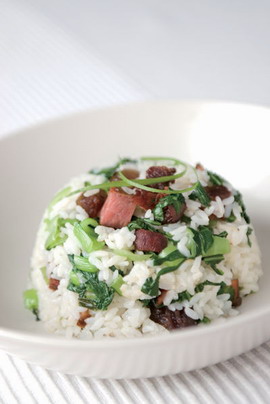 A takeout classic goes traditional
A takeout classic goes traditional
Years ago, an American friend once gave me a simple answer to a now forgotten question: “Xiyun, China has people.” Um. Yes. As obvious an answer as it is an understatement, here is another one. We all eat rice.
We store rice in buckets under our sinks and we buy them by the sack, in sizes usually reserved for garden fertilizer. Apparently, the Chinese first domesticated the grain some 9,000 years ago, and we’ve not let it go since. Rice congee, steamed sticky rice, rice vinegar, rice wine, sweet rice wine soup – rice, rice everywhere. Of all the rice variations, Western versions included (rice pudding, rice salad, risotto), none is able to match the all-around popularity of fried rice.
Thanks to culinary trail blazers like Panda Express, a large fast-food chain in the US, Western palates long ago embraced fried rice. Westernized Chinese fast food has introduced many people to the most basic Asian tastes – green onion and ginger in peanut oil instead of onions in butter. From there on, what’s not to like? It would be unusual to find someone, adult or child alike, who says nay to fried rice. This is crowd pleaser territory.
Done properly, the rice is fragrantly wrapped in fat and sometimes a thin web of egg – tender without being squishy or soggy. Whatever vegetables used are perfectly cubed, tenderly stir-fried, slightly crunchy on the inside. Bright in color and full of flavor, they are clean pops against the luxurious fat of pork.
As for the service, Panda Express did for Chinese food, my grudging tribute ends at soy sauce. The addition of this overpowering condiment is the worst thing that can happen to fried rice. Westerners, for some reason, are addicted to soy sauce. Soy sauce over white rice – perplexing, strange and more than a little insulting to a Chinese cook slaving over a hot stove – is a hard habit to break. But as restaurants in the West cater to heavier Western tastes, over-seasoning has become the rule and soy sauce, king.
Soy sauce in fried rice is usually a lazy, blunt tool. It too easily masks other flavors and leaves rice soggy and gooey. This is not risotto. Fried rice should be dry, with every grain separated. The trick is to use overnight rice, and especially leftover takeout rice sitting forlorn and slightly crusty in the floppy plastic box. In a pinch, you can recreate the moisture-sucking effect of an overnight stay in the fridge by cooking rice with slightly less water than usual, laying it out in a thin layer on a tray and sticking the whole thing in the freezer for 15 minutes.
The varieties are endless. The elements of successful fried rice, however, are ultimately the same: slightly dried out rice, very little or no soy sauce, plenty of fat as coating, small diced vegetables that are evenly cooked and a cooking vessel that allows lots of maneuvering room. A wok helps. That’s pretty much it. Confident chefs might also try spinning a bit of egg around every rice grain by mixing dry, cooked rice with a raw egg or two in its takeout container until everything is gooey.
Here’s a simple, straightforward recipe that doesn’t even employ the egg trick. For a richer rice, you can substitute egg for bok choy. Smoked, cured meat can be easily found in any supermarket and keeps very well in the fridge. Bacon can be substituted if absolutely necessary. Blanching the bok choy is a security blanket. If you are confident in both your wok’s ability to hold heat and your stove top’s firepower (and we’re talking the NASA space launch kind), you can omit this step; otherwise, the bok choy will give off too much water and leave your rice soggy.
Cured Pork and Bok Choy Fried Rice
Serves 4-6
 Ingredients:
Ingredients:
5 large stalks of bok choy (油菜), diced
½ cup cured Chinese pork (腊肉), diced
Peanut oil
1 small stalk of green onions, chopped
1 tsp minced fresh ginger
5 cups of cooked, leftover rice, preferably left overnight in the fridge
Salt
Bring a pot of water to a rolling boil and add a pinch or two of salt. Blanch diced bok choy for 15 seconds or so, just until the leaves turn emerald green. Drain. In a wok, heat peanut oil and add pork when the oil just begins to smoke. Stir-fry one to two minutes until fragrant. Add green onion and ginger and stir; toss in the blanched bok choy. Add rice, breaking up chunks into individual kernels, and cook until just warmed through and fat glistens evenly on rice. Season carefully with salt to taste, since the pork is already salty.



